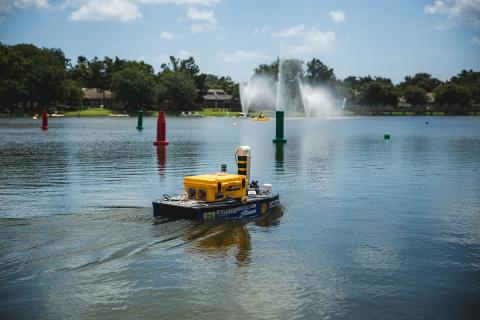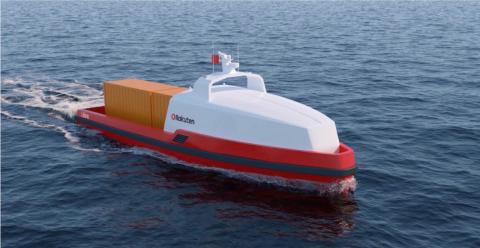Late last month, Monterey Bay Aquarium Research Institute (MBARI) engineers demonstrated using MBARI’s long-range AUV (LRAUV) for detecting and tracking oil spills.
The engineers, who worked with the US Coast Guard and collaborators at Woods Hole Oceanographic Institution (WHOI), equipped an LRAUV with special instruments (fluorometers) that can detect oil in water. During the recent test in Monterey Bay, the MBARI team simulated an oil spill using non-toxic, biodegradable dye.
According to MBARI, the Coast Guard is very interested in testing robots that can find and track oil spills under ice; a capability that will be crucial as ship traffic and oil exploration expands in the Arctic Ocean, MBARI says.
Maritime
Maritime
Hundreds of teams from around the globe go robot to robot in 2018 RoboNation competitions
Three hundred and fifty teams. Forty-four countries. Seven competitions. One community.
After spending an entire year or more working tirelessly to create robotic vehicles, teams from all over the world attempted one or more of the seven competitions sponsored by RoboNation, the new name of the former AUVSI Foundation. Not only were these students in school while they worked on their projects, many had jobs and internships, on top of finding the time and resources to build a successful system.

General Dynamics releases new Bluefin-9 autonomous UUV
During Oceans 2018 in Charleston, South Carolina on Tuesday, Oct. 23, General Dynamics Mission Systems released the new Bluefin-9 autonomous UUV.
Completely reengineered, the vehicle provides defense, commercial and academic customers with highly-detailed subsurface data in just minutes thanks to the combination of high navigational accuracy, outstanding sonar resolution, and precision manufacturing.
Capable of providing the same data collection capabilities of larger UUVs, the two-man portable Bluefin-9 autonomous UUV can be deployed and recovered from piers, a rigid-hulled inflatable boat (RHIB) or other vessels of opportunity.

L3 ASV receives funding for "pioneering project" on autonomous navigation of maritime vessels
L3 ASV has received funding from the U.K. government for a “pioneering project” on autonomous navigation of maritime vessels.
Along with its partners in the Maritime & Coastguard Agency (MCA) and United Kingdom Hydrographic Office (UKHO), L3 ASV will conduct a study that focuses on the “future of marine navigational data and charts.”
Funded by the Department for Transport’s Transport Technology Research Innovation Grant (T-TRIG), the project will look to promote early-stage science, engineering or technology innovations, with the potential to advance the U.K.’s transport system.
To start, L3 ASV’s T-TRIG project will explore the characteristics of navigational data and charts in terms of what they’re made of, their structure and how they are updated.

Alion awarded contract to develop, build, and support the U.S. Navy UUV Family of Systems
A McLean, Virginia-based company called Alion Science and Technology has been awarded a multiple award contract (MAC) Indefinite Delivery/Indefinite Quantity (ID/IQ) from the Department of Navy, Naval Undersea Warfare Center, Newport, Rhode Island, to develop, build, and support the U.S. Navy UUV Family of Systems (FoS).
According to Alion, the scope of the contract covers systems and subsystems required to support the advancement of UUV FoS, which not only includes current UUV systems and subsystems, but also any future UUV systems and subsystems.
Alion says that the value of the contract, with all option years, is $794M.

AutoNaut USV looks to play a role in removing plastic from the world's oceans
An AutoNaut USV has been launched alongside “Wilson,” which is the Ocean Cleanup System 001 from a non-profit organization called The Ocean Cleanup that is deploying advanced technologies to remove plastic from the world’s oceans.
While deployed, the AutoNaut USV will conduct long-term monitoring of the surrounding environmental conditions. It will also provide information on “Wilson” itself, which is currently undergoing sea trials approximately 350 nautical miles from San Francisco to test the behavior of the system.
“We are thrilled to be playing a role in Boyan Slat’s vision,” says Phil Johnston, BD at AutoNaut.

Sea Machines Robotics introduces new autonomous technology for marine vessels
Sea Machines Robotics has successfully completed product sea trials of its introductory line of intelligent command and control systems, which have been developed to meet the challenges of offshore commercial, scientific and government applications, the company says.
According to Sea Machines Robotics, the two new products, SM300 and SM200, take the marine industry into a new era of “task-driven, computer-guided vessel operations”; ultimately bringing advanced autonomy “within reach” for small- and large-scale operators.

From Unmanned Systems Magazine: Automated Shipping Could Lead to Maritime Rules Changes
The International Maritime Organization (IMO), a United Nations agency that sets global rules for shipping, is undertaking a “scoping exercise” to explore whether any of its regulations should be changed to accommodate the expected advent of autonomous ships.
The research effort will first review IMO rules to see whether they apply to Maritime Autonomous Surface Ships (MASS) and would preclude MASS operations. The exercise will then “determine the most appropriate way of addressing MASS operations,” says IMO spokeswoman Natasha Brown.

Royal Netherlands Navy equips its New Generation Remus 100 AUV Fleet with SeeByte's Neptune software
The Royal Netherlands Navy (RNLN) has successfully integrated SeeByte’s Neptune software into its New Generation Remus 100 AUV Fleet.
Neptune is SeeByte’s goal based mission planning and autonomy engine software. The software allows for the expedition and optimization of single and multi-vehicle operations.
“We are privileged to be in a position to continue working with The Royal Netherlands Navy and assist in their goal to achieve security at and from the sea,” says SeeByte’s Technical Client Manager, Alastair Cormack.

RE2 Robotics receives $2.5 million contract to continue developing its Dexterous Maritime Manipulation System
RE2 Robotics, which develops humanlike robotic manipulator arms, has received a $2.5 million contract from the Office of Naval Research to continue developing and commercializing its Dexterous Maritime Manipulation System (DM2S).
Equipped with RE2’s DM2S technology, Navy Explosive Ordnance Disposal (EOD) personnel will be able to “remotely and effectively” address Waterborne Improvised Explosive Devices (WBIEDs).
“As with the majority of our robotic technologies, the goal of the DM2S is to keep humans out of harm’s way while performing dangerous tasks,” says Jorgen Pedersen, president and CEO of RE2 Robotics.

